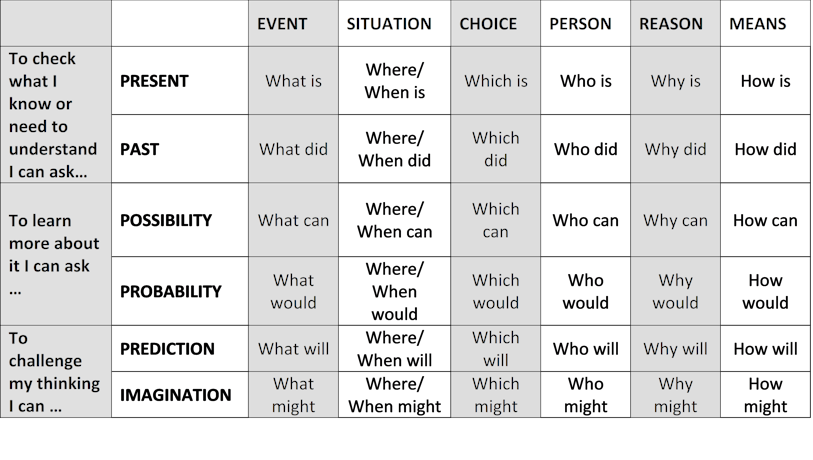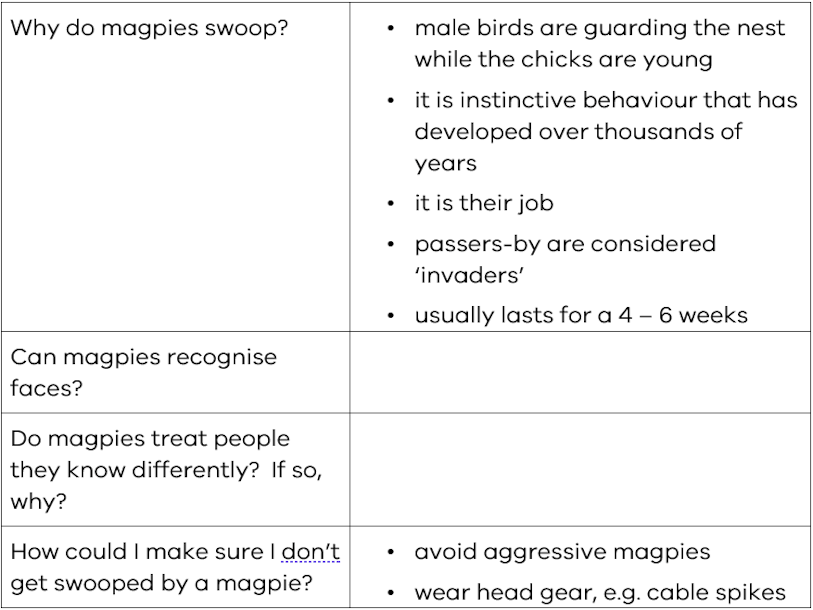Suggested Learning Intentions
- To pose questions about the natural world
- To locate information to answer questions
Sample Success Criteria
- I can pose clarifying and probing questions
- I can gather information to answer my questions
- Paper strips for students to write their personal wonderings
- Chuck Weiderhold’s Question Matrix to support student questioning
- A range of non-fiction reading material about animal and plant features
- Access to digital resources
- Text Features Plenary: docx PDF
Introduce the big understandings that run throughout this unit:
- Non-fiction texts provide us with information to explore and understand the natural world
- Living things have structural features and behaviours (adaptations) that help them survive in their environment
Link the big understandings with a personal wondering. Tell a story about something you witnessed that made you curious. For example:
“Have you noticed there are a lot of magpies around at the moment? I am often worried that they will swoop …
Someone told me that magpies can recognise faces and won’t swoop people that they know and trust.
I wonder if this is true. How might I find out?”
Demonstrate writing your wondering as a series of questions:
- Why do magpies swoop?
- Where are you most likely to get swooped by a magpie?
- When do magpies swoop?
- Can magpies recognise faces?
- Do magpies treat people they know differently?
- If so, why?
- How could I make sure I don’t get swooped by a magpie?
Invite your students to wonder about the natural world.
Ask questions to prompt their wonderings. For example:
- Have you ever wondered why living things behave the way they do?
- Have your ever wondered how particular plants and animals survive in their environment?
You could take the students outside and use observation to come up with their personal wonderings.
Provide Chuck Weiderhold’s Question Matrix to support student questioning.

(Source: Chuck Weiderhold in consultation with Spencer Kagan c2007, Cooperative learning & higher-level thinking : the Q-matrix).
Allow time for students to discuss and write their own wondering statements.
Share and discuss student wonderings/questions.
Sort students’ wonderings into open and closed questions.
Display wonderings clearly in the classroom. Ask the students to identify similar themes and ideas and demonstrate how similar wonderings could be grouped together and placed on the class wonder wall.
Enable students who are having difficulty posing clear questions by providing question stems such as: What is…? Why …? How does…? How can …?
Extend student questioning and thinking skills by suggesting they ask open and closed questions and use question stems from the probability, prediction and imagine part of the Question Matrix.
Model researching methods to answer the teacher-generated wonderings. Demonstrate the need to ask specific questions and model skimming and scanning for key information in the text.
For example, type ‘Australian magpie’ into the search engine and view a text providing general information.
This site on the Australian magpie provides the opportunity to scan a table of contents and link directly to information on swooping. It has clear subheadings that make the text easy to navigate and to skim to find relevant information.
After reading the written text and viewing the embedded video, Australian Magpie Dangerous Attack, ask students if this text answered your questions.
Demonstrate using information from the written and visual texts to take notes relevant to each question.

Discuss the information gained from the video and written text and the questions that were and were not answered from the above table.
Ask, "How could I find information to determine if magpies can recognise human faces?" and discuss student responses.
Type, "Can magpies recognise human faces?" into the search engine.
Discuss the reliability and readability of the search results. Ask students how they might assess the reliability of different sources. For example, who is the author? Who has published the information?
Choose another source to gather further information. For example this ABC news article with written and visual text, or an episode of Behind the News, Magpie Season.
Model reading and note taking to answer specific questions in the table above.
Ask if the new information prompted new questions? For example, “I would like to know more about swooping as an instinctive behaviour that has developed over thousands of years. I wonder what other adaptations help the magpie survive in today’s environment?”
Support students to research their personal wonderings about the natural world.
- Allow time for students to read a number of relevant texts to research their questions. Ensure students have access to suitable digital and print resources.
- Provide a range of graphic organisers and guide students to select an appropriate method to organise their thinking and collect and record information. For example, a Mind Map, Fish Bone, or KWHL.
- Refer to the Question Matrix to refine or expand student wonderings and questions if required.
Support students to organise themselves into collaborative pairs. Suggest research roles for collaboration. For example, one person reads and pauses at key ideas, after discussion, the other person notes the key ideas in dot points. Alternatively, students read separate texts then discuss and synthesise information.
Facilitate a group discussion, reflecting on the research using the following prompts:
- Identify questions that were easily answered.
- Identify questions that were not answered. Discuss why this may have been the case.
- Identify questions that needed information from a number of sources.
- Identify questions that led to further questions.
- Refer to the big understandings: Ask, “What have we learned about adaptations?”
Explain that students will have the opportunity to research their questions while developing their understanding of how non-fiction texts work.
Encourage students to collect information texts related to their wonderings/questions for future research.
Enable students requiring further support, by assisting them to select reading material that is appropriate for their independent reading level, or setting up a guided reading group to support student comprehension of more challenging texts.
Arrange students into collaborative and mixed ability groups so that all students are supported by their peers.
Share and discuss student wonderings and their discoveries.
Consider:
- Have students asked clarifying, probing questions, open and/or closed question?
- Have they asked questions that lead to a deeper understanding?
ABC, 2019. Magpie Season. [Online]
Available at: www.abc.net.au/btn/classroom/magpie-season/11506086
[Accessed 15 March 2022].
ABC, 2019. Magpie Season and Frozen Dragon. [Online]
Available at: www.abc.net.au/kidslisten/news-time/magpie-season-and-frozen-dragon/11528788
[Accessed 15 March 2022].
Animal Spot, 2019. Australian Magpie. [Online]
Available at: www.animalspot.net/australian-magpie.html
[Accessed 15 March 2022].
Brown, S., 2017. Magpies swooping? You should try making friends with them, expert says, ABC News, 31 August. [Online]
Available at: www.abc.net.au/news/2017-08-31/make-friends-with-magpies-to-avoid-swooping-expert-says/8856438
[Accessed 15 March 2022].
Litemind, 2019. What is Mind Mapping? (and How to Get Started Immediately). [Online]
Available at: litemind.com/what-is-mind-mapping/
[Accessed 15 March 2022].
Second Level Support Service, 2008. Using Graphic Organisers in Teaching and Learning. [Online]
Available at: pdst.ie/sites/default/files/GraphicOrganiserFinal.pdf
[Accessed 15 March 2022].
Tech4Learning, 2019. KWHL. [Online]
Available at: www.graphicorganizer.net/samples/kwhl.pdf
[Accessed 15 March 2022].
Other stages
1. Defining Physical and Behavioural Adaptations
EXPLORESuggested Learning Intentions
- To understand how adaptations help living things survive in different habitats
Sample Success Criteria
- I can explain what is meant by the term 'adaptation’
- I can explain how a particular adaptation helps a living thing survive
3. Features of Non-Fiction Texts
EXPLORESuggested Learning Intentions
- To examine the structures of information and explanation texts
- To understand the purpose of text structures
Sample Success Criteria
- I can identify specific text structures such as headings, subheadings, indexes and glossaries
- I can explain the purpose of specific text structures
4. Paragraphs: Finding the Main Idea and Supporting Details
EXPLORESuggested Learning Intentions
- To understand the features and purpose of paragraphs
Sample Success Criteria
- I can identify the topic sentence and supporting detail in a paragraph
- I can write a paragraph with a topic sentence and supporting detail
5. Using Vocabulary to Improve Meaning
EXPLORESuggested Learning Intentions
- To understand how vocabulary adds meaning to writing
Sample Success Criteria
- I can identify how vocabulary in texts adds to the meaning of the text
- I can use topic specific vocabulary in my writing
6. Researching and Creating Non-Fiction Texts
EXPLORESuggested Learning Intentions
- To plan, draft and publish a non-fiction text
Sample Success Criteria
- I can use non-fiction text structures, such as headings, sub-headings, paragraphs and images in my writing
- I can use topic specific vocabulary